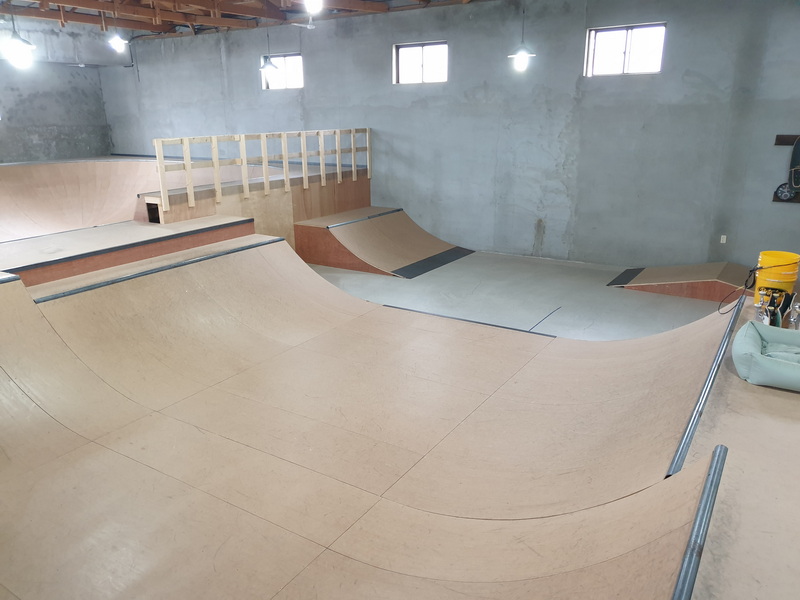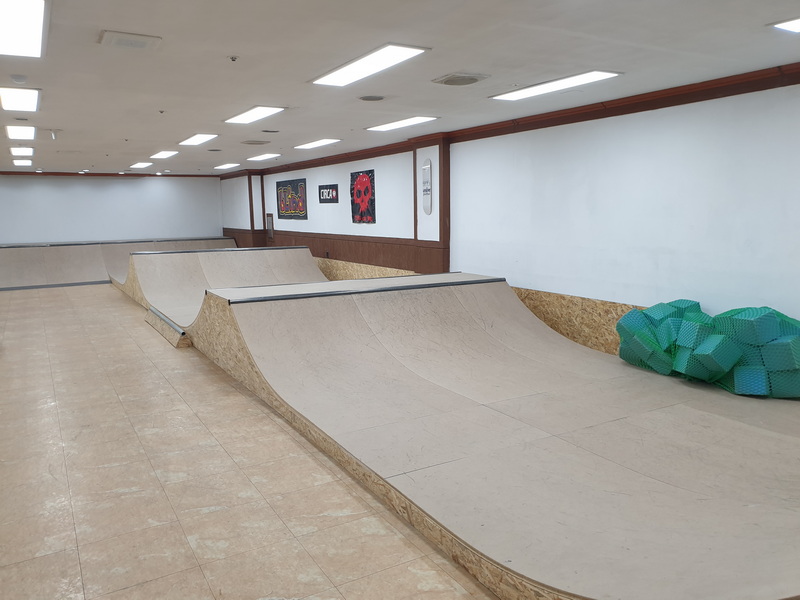The Rise of Indoor Skateparks
By William Urbanski
As a wee lad in Ontario, Canada, nothing was more exciting or mythical than an indoor skatepark. Even so much as a rumor of an indoor skatepark was enough to make my friends and I pile into a jalopy and hightail it off to the nether regions of the province. In the late 90s and early 2000s, the few and rare skateparks that existed in Ontario were nothing short of legendary and were literal hubs of skateboarding activity and culture. The stories of what tricks were done and what international pros came by to put on a demo are, to this day, firmly etched into my psyche. Not many of these skateparks lasted more than a couple of years at most (skateboarders are not exactly known for their business-prowess), but their effects live on through the ages.
Fast forward twenty-some years and I am happy to see that Korea is undergoing its own golden age of indoor skateparks. While free, outdoor skateparks are not difficult to find countrywide (except for in Gwangju*), they tend to be cookie-cutter and very hit-and-miss in terms of quality and fun factor. Indoor skateparks, on the other hand, are almost always amazing and have excellent build-quality – probably owing to the fact that they are owned and managed by, you know, people who actually skateboard and are not the product of some fat cat in some city hall.
During the past winter, after being forced to cancel a trip abroad due to omicron-a-bing-bong restrictions, I decided that instead of bumming around the house like a Grumpy Gus, I would visit several of the newest parks around the country. What follows is a chronicle of that wintertime journey, undertaken like a modern-day voyageur, traveling into the vast unknown.
Jeju Pipeline (@jeju_pipeline)
Distance from Gwangju: 2 hours (by plane and bus)

Located near Seogwipo in the southern region of Jeju, Jeju Pipeline was by far my favorite indoor skatepark experience of the winter. In terms of “adventure,” fun factor, and all-around good times, this place was the best.
Taking a flight just to visit a skatepark may sound excessive, but depending on the time of year, flying to Jeju from Gwangju can be both quick and economical. After hopping from the subway to the airport, checking in and finding my way to the plane, it was only a forty-five-minute flight to the island. Being a domestic flight, getting through security and everything was a breeze, and from Jeju International Airport, there was a bus that dropped me off a mere ten minutes from the skatepark. All in all, from takeoff in Gwangju, I was at the skatepark in a little over two hours.
Located in a nice little building next to a hallabong orange orchard, Jeju Pipeline houses a perfect mini-ramp, a bowl, a “mini” mini-ramp, as well as a flat area for pushing around. The building itself is spacious, well lit, and very well laid out. A common problem with indoor skateparks is that they try to add too much, resulting in a “cramped” feeling, but Jeju Pipeline struck an excellent balance by focusing on building fewer but better ramps. To me, what really set this park apart was the incredible build quality of all the ramps: Only top-notch materials were used and the geometry of everything was perfect.
Overall, Jeju Pipeline had a very “family-friendly” vibe, and over the course of two days, numerous parents dropped by to watch and encourage their kids to skateboard. (On a sidenote, virtually all the kids who showed up went to international schools and spoke perfect English.) As is common in Korea, it was also nice to see a lot of women and girls skating.
Since it was not really feasible to come back to Gwangju on the same day, I ended up staying in a nearby pension that was not fancy but all-around decent, especially since there was a McDonald’s nearby. After two days of hard-skating, I was sorry to have to leave, and my only regret from this whole experience was that I was not able to make it back a second time (at least not yet).
Sejong C.RUZA (@c.ruzapark_sejong)
Distance from Gwangju: 2.5 hours (by car)

C.RUZA is actually a skatepark franchise that started in Yangpyeong, Gyeonggi-do. The first park, which is still in operation, is, from what I can gather, the first indoor skatepark in Korea. Now, there are also C.RUZA locations in Yangsan, Pohang, and of course, Sejong. As a bonus, the owner of the park is originally from Gwangju!
Of all the skatepark I visited, this one was probably the nicest. The building is brand new, all the ramps are of exceptional quality, and it is just a fun place to spend the day. There are beautiful mini-ramps and a wide street course with perfect ledges and rails. One thing to be aware of is that the scale of some ramps is bigger than I expected. For example, Sejong C.RUZA has a flawless bowl (which are quite rare and even harder to make), but it was way bigger and scarier than I imagined. With some practice and more time, it would be possible to adapt to, but on this first trip, I had trouble doing even my basic tricks, and my buddy ended up giving himself a fat lip after slipping out and whacking his face on the bottom. He dusted himself off and was okay, though!
One slight drawback about this park is that it is located in an industrial park, and I am not sure if it would be possible to get there using public transportation. You basically need a vehicle to get there, so my recommendation is to pack all your buddies into your car and make a day trip out of it. While the scale of some of the ramps and the location were slight drawbacks, the park overall is beautiful and a ton of fun. In the summer, I will be going back.
Gimhae Skatepark (@gimhae_skateboard)
Distance from Gwangju: 3+ hours by intercity bus and car

This park was the “hidden gem” of my winter adventures. After seeing pictures of it on Instagram, I did not have high hopes, but I ended up having a great time there. All in all, Gimhae Skatepark had enough elements that kept it interesting. My only minor gripe would be that some of the quarterpipes and the main mini-ramp were too steep and high for my liking, but like everything, with a little more time it would be no problem. Everyone at this park was super friendly and, as a sidenote, the owner of the park has even started his own skateboard deck and wheel companies.
Union Skatepark (@union_skatepark)
Distance from Gwangju: About 3 hours by intercity bus

In the southeastern city of Changwon, Union Skatepark is a dream come true for anyone who likes perfectly built mini-ramps. While not extremely large and located in a building’s basement, this place was so fun that I actually went twice.
This skatepark has a little bit of an interesting backstory. When it first opened up (in another location), it was below a coffee shop that complained so incessantly about the noise that the park was only allowed to operate when the coffee shop was closed (i.e., hardly ever), meaning that, basically, you could not ever go there. Thankfully, it moved to the new location and shows what can be accomplished when any space is used well. Similar to Jeju Pipeline, Union Skatepark strikes a great balance between having a good amount of ramps without having too many, resulting in a space that, while not extremely large, feels open and not-at-all congested.
If I were a kid growing up in Changwon, I would beg and plead for my parents to buy me a season pass to Union Skatepark and spend as much time as possible there. In addition to being an amazingly fun park, it had a “clubhouse” feel where people could also hang out and talk about all things skateboarding.
The “Skateboard Academy”
What the owners of skateparks in Ontario, Canada, all discovered in time is that it is actually really hard to make money by charging kids ten bucks apiece to skateboard for a few hours. There are a few ways around this conundrum: The most obvious one being city funding, which is hard to come by and opens the facility up to unwarranted scrutiny by outsiders (read: “Karens”). Most skateparks also run skate shops, which are also not exactly known to be money-making enterprises. Probably the most effective “indoor skatepark business model” that I have ever come across is having the park not be a stand-alone business at all, but rather a subsidiary or part of something larger. For example, a friend of mine had a massive print shop (for branded clothing) that had enough room for a skatepark in the back.
The Korean approach has been much different and makes for an interesting case study: Most of these parks actually act as quasi “skateboard academies.” Parents drop their kids off and the park employees supervise and give lessons, followed by free time. This is the rule, rather than the exception and also solves the reputational problems that North American skateparks struggle to overcome. Instead of a gathering place for hooligans, Korean indoor skateparks are a place where kids can engage in a fun activity under the guidance of those who know what they are doing.
Twenty years ago in North America, the “average skater kid” would have scoffed at the idea of charging for skateboard lessons. After all, skateboarding was supposed to be an activity far removed from the rules and scheduled practice times that characterize mainstream sports. But times have changed and South Korea’s skateboard lessons at indoor skateparks not only make perfect sense but also fit into an established social model (aka “the hagwon system”) while encouraging a healthy, productive activity that acts as an alternative to staring at a computer monitor for hours on end.

Pushing Forward
This article is just a small sample of the indoor parks in the country. In 2021 “skatepark academies” have popped up in Busan, Iksan, Wonju, Gyeonggi-do, and numerous locations in Seoul. And just to be clear, you do not have to take lessons at any of these places. For between fifteen and twenty thousand won, anyone can skate all day.
While I do not expect a legit indoor skatepark to open in Gwangju anytime soon, the ruggedness and tenacity of Gwangju skateboarders ensures longevity far beyond what a single, physical location ever could. That being said, the role that indoor skateparks play in growing and supporting the nationwide skateboard ecosystem cannot be overstated. Fortunately, the decentralized network of indoor skateparks in Korea is growing stronger by the day, and if you have ever thought about learning to skateboard, the time to start was yesterday.
* See my August 2021 article in the Gwangju News, “Gwangju Skateparks: My Vision for Their Future.” https://gwangjunewsgic.com/community/sports/gwangju-skateparks/
Photographs and graphic courtesy of William Urbanski.
The Author
William Urbanski is the managing editor of the Gwangju News and its special skateboarding correspondent. Instagram: @will_il_gatto







